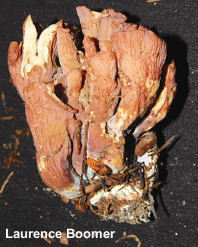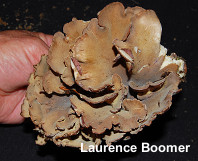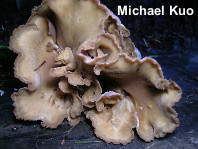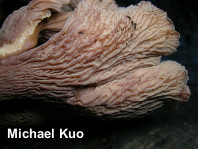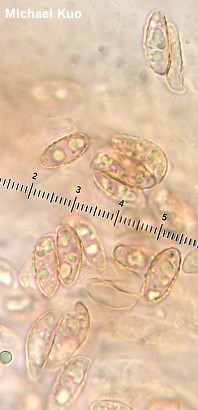| Major Groups > Chanterelles and Trumpets > Gomphoid Mushrooms > Gomphus clavatus |

|
Gomphus clavatus [ Basidiomycota > Gomphales > Gomphaceae > Gomphus . . . ] by Michael Kuo Sometimes called "pig's ears," Gomphus clavatus is an odd mushroom. One, two, or more irregularly shaped, lobed caps arise from a common stem, and the mushroom's underside is wrinkled and purplish. It is a mycorrhizal partner with northern and montane conifers—especially spruces and firs. Gomphus clavatus is a European species, first named in 1796 by Persoon. Research from Giachini (2004) has more or less upheld the traditional concept of Gomphus clavatus—which is now apparently the only North American species of Gomphus, since other former Gomphus species on our continent have been transferred to other genera (notably, Turbinellus). See the page on gomphoid mushrooms for details. Gomphus brevipes and Gomphus truncatus are identical to Gomphus clavatus, according to Giachini, and should be treated as synonyms. Thanks to Laurence Boomer for collecting, documenting, and preserving Gomphus clavatus for study; his collection is deposited in The Herbarium of Michael Kuo. Description: Ecology: Mycorrhizal with conifers (especially spruces and firs); growing alone, scattered, or gregariously; summer and fall—or over winter on the West Coast; originally described from Bavaria; widespread in Europe; in North America distributed in northern and montane areas, and in the Pacific Northwest. The illustrated and described collections are from California and Oregon. Fruiting Body: By maturity with one, two, or more caps arising from a shared stem and often fusing together at their edges; up to 15 cm high and 20 cm across. Cap: Lobed and irregular in outline; broadly convex at first, becoming shallowly to deeply depressed; dry; bald or with a few scattered, tiny scales; pale brown with lilac shades when fresh, fading to creamy tan. Undersurface: Running down the stem; deeply wrinkled and cross-veined; dark lilac or purple when young but usually fading to pale lilac. Stem: Often difficult to define with precision, but usually about 2–4 cm high and 1–3 cm wide; whitish below; lilac near the undersurface; sometimes bruising reddish brown; bald above, but with a somewhat velvety base; basal mycelium white. Flesh: Yellowish white to pale lilac. Odor and Taste: Not distinctive. Spore Print: Brownish. Microscopic Features: Spores 11–16 x 4.5–6.5 µm; long-ellipsoid to subamygdaliform; often flattened on the abaxial side; verrucose; hyaline to brownish in KOH, with numerous oil droplets. Basidia 50–65 x 10–12 µm; subclavate; 4-sterigmate. Cystidia not found. Clamp connections present. REFERENCES: (Persoon, 1796) Gray, 1821. (Fries, 1821; Saccardo, 1888; Corner, 1966; Smith, 1968; Smith, Smith & Weber, 1981; Thiers, 1985; Arora, 1986; Breitenbach & Kränzlin, 1986; Phillips, 1991/2005; Lincoff, 1992; Persson, 1997; Barron, 1999; Pilz et al., 2003; Roody, 2003; Giachini, 2004; McNeil, 2006; Miller & Miller, 2006; Kuo, 2007; Nonis, 2007; Trudell & Ammirati, 2009; Giachini & Castellano, 2011; Buczacki et al., 2012; Desjardin, Wood & Stevens, 2015; Evenson, 2016; Siegel & Schwarz, 2016; baroni, 2017; Gminder & Böhning, 2017; Læssøe & Petersen, 2019; McKnight et al., 2021; MacKinnon & Luther, 2021.) Herb. Kuo 09051301. This website contains no information about the edibility or toxicity of mushrooms. |
© MushroomExpert.Com |
|
Cite this page as: Kuo, M. (2021, August). Gomphus clavatus. Retrieved from the MushroomExpert.Com Web site: http://www.mushroomexpert.com/gomphus_clavatus.html |
